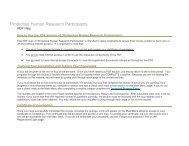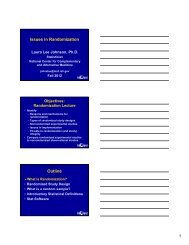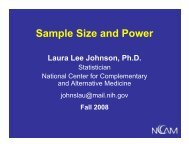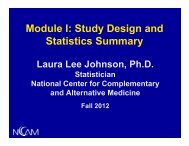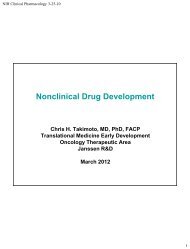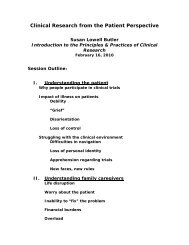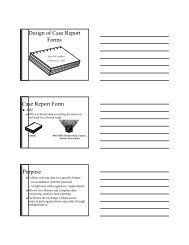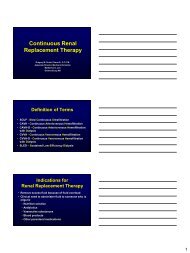Sample Size and Power
Sample Size and Power
Sample Size and Power
Create successful ePaper yourself
Turn your PDF publications into a flip-book with our unique Google optimized e-Paper software.
<strong>Sample</strong> <strong>Size</strong> <strong>and</strong> <strong>Power</strong><br />
Laura Lee Johnson, Ph.D.<br />
Statistician<br />
National Center for Complementary<br />
<strong>and</strong> Alternative Medicine<br />
johnslau@mail.nih.gov<br />
Fall 2010
Misconceptions<br />
• P-value = inferential tool ? Yes<br />
– Helps demonstrate that population means<br />
in two groups are not equal<br />
• Smaller p-value → larger effect ?<br />
No<br />
– Effect size is determined by the difference<br />
in the sample mean or proportion between<br />
2 groups
Misconceptions<br />
• A small p-value means the difference is<br />
statistically significant, not that the<br />
difference is clinically significant. YES<br />
– Al large sample size can help get a small p-<br />
value. YES, so do not be tricked.<br />
• Failing to reject H 0 means what?<br />
– There is not enough evidence to reject H 0 YES<br />
– H 0 is true! NO NO NO NO NO!
Objectives<br />
• Calculate changes in sample size<br />
based on changes in the difference of<br />
interest, variance, or number of study<br />
arms<br />
• Underst<strong>and</strong> intuition behind power<br />
calculations<br />
• Recognize sample size formulas for the<br />
tests<br />
• Learn tips for getting g through an IRB
Take Away Message<br />
• Get some input from a statistician<br />
– This part of the design is vital <strong>and</strong><br />
mistakes can be costly!<br />
• Take all calculations with a few grains<br />
of salt<br />
– “Fudge factor” is important!<br />
• Round UP, never down (ceiling)<br />
– Up means 10.01 becomes 11<br />
• Analysis Follows Design
Vocabulary<br />
• Arm = <strong>Sample</strong> = Group<br />
• Demonstrate superiority<br />
– Detect difference between treatments<br />
• Demonstrate equally effective<br />
– Equivalence trial or a 'negative' trial<br />
– <strong>Sample</strong> size required to demonstrate<br />
equivalence larger than required to<br />
demonstrate stateada difference ee • Demonstrate non-inferiority<br />
– Lots of issues
Superiority vs. Equivalence<br />
Superiority<br />
Superiority
Non-Inferiority
Vocabulary (2)<br />
• Follow-up period<br />
– How long a participant is followed<br />
• Censored<br />
– Participant is no longer followed<br />
• Incomplete follow-up (common)<br />
• Administratively censored (end of<br />
study)<br />
• More in our next lecture
Outline<br />
‣<strong>Power</strong><br />
• Basic <strong>Sample</strong> <strong>Size</strong> Information<br />
• Examples (see text t for more)<br />
• Changes to the basic formula<br />
• Multiple comparisons<br />
• Poor proposal sample size statements<br />
• Conclusion <strong>and</strong> Resources
<strong>Power</strong> Depends on <strong>Sample</strong> <strong>Size</strong><br />
• <strong>Power</strong> = 1-β = P( reject H 0 |H 1 true )<br />
– “Probability of rejecting the null<br />
hypothesis if the alternative<br />
ti<br />
hypothesis is true.”<br />
• More subjects higher power
<strong>Power</strong> is Affected by…..<br />
• Variation in the outcome (σ 2 )<br />
– ↓ σ 2 → power ↑<br />
• Significance level (α)<br />
– ↑ α → power ↑<br />
• Difference (effect) to be detected (δ)<br />
– ↑δ →power ↑<br />
• One-tailed vs. two-tailed tests<br />
– <strong>Power</strong> is greater in one-tailed tests than in<br />
comparable ab two-tailed ta tests
<strong>Power</strong> Changes<br />
• 2n = 32, 2 sample test, 81% power,<br />
δ=2, σ = 2, α = 0.05, 2-sided test<br />
• Variance/St<strong>and</strong>ard deviation<br />
– σ: 2 → 1 <strong>Power</strong>: 81% → 99.99%<br />
– σ: 2 → 3 <strong>Power</strong>: 81% → 47%<br />
• Significance level (α)<br />
– α : 0.05 → 0.01 <strong>Power</strong>: 81% → 69%<br />
– α :0.05→ 0.10 <strong>Power</strong>: 81% → 94%
<strong>Power</strong> Changes<br />
• 2n = 32, 2 sample test, 81% power, δ=2, ,<br />
σ = 2, α = 0.05, 2-sided test<br />
• Difference to be detected (δ)<br />
– δ : 2 → 1 <strong>Power</strong>: 81% → 29%<br />
– δ : 2 → 3 <strong>Power</strong>: 81% → 99%<br />
• <strong>Sample</strong> size (n)<br />
– n: 32 → 64 <strong>Power</strong>: 81% → 98%<br />
– n: 32 → 28 <strong>Power</strong>: 81% → 75%<br />
• Two-tailed vs. One-tailed tests<br />
– <strong>Power</strong>: 81% → 88%
<strong>Power</strong> should be….?<br />
• Phase III: industry minimum = 80%<br />
• Some say Type I error = Type II<br />
error<br />
• Many large “definitive” studies<br />
have power around 99.9%<br />
• Proteomics/genomics i studies: aim<br />
for high power because Type II<br />
error a bear!
<strong>Power</strong> Formula<br />
• Depends on study design<br />
• Not hard, but can be VERY algebra<br />
intensive<br />
• May want to use a computer<br />
program or statistician
Outline<br />
<strong>Power</strong><br />
‣Basic <strong>Sample</strong> <strong>Size</strong> Information<br />
• Examples (see text t for more)<br />
• Changes to the basic formula<br />
• Multiple comparisons<br />
• Rejected sample size statements<br />
• Conclusion <strong>and</strong> Resources
Basic <strong>Sample</strong> <strong>Size</strong><br />
• Changes in the difference of interest have<br />
HUGE impacts on sample size<br />
– 20 point difference → 25 patients/group<br />
– 10 point difference → 100 patients/group<br />
– 5 point difference → 400 patients/group<br />
• Changes in difference to be detected, α, β, σ,<br />
number of samples, if it is a 1- or 2-sided test<br />
can all have a large impact on your sample<br />
size calculation<br />
Basic 2-Arm Study’s<br />
2 2<br />
4( Z1 −α/2 + Z1<br />
−β)<br />
σ<br />
TOTAL <strong>Sample</strong> <strong>Size</strong> = 2N<br />
=<br />
2<br />
δ
Basic <strong>Sample</strong> <strong>Size</strong> Information<br />
• What to think about before talking<br />
to a statistician<br />
• What information to take to a<br />
statistician<br />
– In addition to the background to the<br />
project
Nonr<strong>and</strong>omized?<br />
• Non-r<strong>and</strong>omized studies looking<br />
for differences or associations<br />
– Require larger sample to allow<br />
adjustment for confounding factors<br />
• Absolute sample size is of interest<br />
– Surveys sometimes take % of<br />
Surveys sometimes take % of<br />
population approach
Take Away<br />
• Study’s primary outcome<br />
– Basis for sample size calculation<br />
– Secondary outcome variables considered<br />
important? Make sure sample size is<br />
sufficient<br />
• Increase the ‘real’ sample size to reflect loss<br />
to follow up, expected response rate, lack of<br />
compliance, etc.<br />
– Make the link between the calculation <strong>and</strong><br />
increase<br />
• Always round up<br />
– <strong>Sample</strong> size = 10.01; 01; need 11 people
<strong>Sample</strong> <strong>Size</strong> in Clinical Trials<br />
• Two groups<br />
• Continuous outcome<br />
• Mean difference<br />
• Similar ideas hold for other<br />
outcomes
<strong>Sample</strong> <strong>Size</strong> Formula Information<br />
• Variables of interest<br />
– type of data e.g. continuous, categorical<br />
• Desired power<br />
• Desired significance level<br />
• Effect/difference of clinical importance<br />
• St<strong>and</strong>ard d deviations of continuous<br />
outcome variables<br />
• One or two-sided tests
<strong>Sample</strong> <strong>Size</strong> & Data Structure<br />
• Paired data<br />
• Repeated measures<br />
• Groups of equal sizes<br />
• Hierarchical or nested data<br />
• Biomarkers<br />
• Validity (of what) studies
<strong>Sample</strong> <strong>Size</strong> & Study Design<br />
• R<strong>and</strong>omized controlled trial (RCT)<br />
• Block/stratified-block r<strong>and</strong>omized trial<br />
• Equivalence trial<br />
• Non-r<strong>and</strong>omized intervention study<br />
• Observational study<br />
• Prevalence study<br />
• Measuring sensitivity <strong>and</strong> specificity
Outline<br />
<strong>Power</strong><br />
Basic sample size information<br />
‣Examples l (see text t for more)<br />
• Changes to the basic formula<br />
• Multiple comparisons<br />
• Rejected sample size statements<br />
• Conclusion <strong>and</strong> Resources
Phase I: Dose Escalation<br />
• Dose limiting toxicity (DLT) must<br />
be defined<br />
• Decide a few dose levels (e.g. 4)<br />
• At least three patients will be<br />
treated on each dose level (cohort)<br />
• Not a power or sample size<br />
calculation issue
Phase I (Old Way)<br />
• Enroll 3 patients<br />
• If 0 out of 3 patients develop DLT<br />
– Escalate to new dose<br />
• If DLT is observed in 1 of 3 patients<br />
– Exp<strong>and</strong> cohort to 6<br />
– Escalate if 0 out of the 3 new patients<br />
do not develop DLT (i.e. 1/6 at that<br />
dose develop DLT)
Phase I (cont.)<br />
• Maximum Tolerated Dose (MTD)<br />
– Dose level immediately below the<br />
level l at which h ≥2 patients t in a cohort<br />
of 3 to 6 patients experienced a DLT<br />
• Usually go for “safe dose”<br />
– MTD or a maximum dosage that is<br />
MTD or a maximum dosage that is<br />
pre-specified in the protocol
Phase I<br />
Enroll 3 people<br />
0/3 DLT 1/3 DLT 2 or 3 / 3 DLT<br />
Escalate to<br />
new dose<br />
Enroll 3 more<br />
at same dose<br />
0/new 3 DLT 1 or more /<br />
new 3DLT<br />
Escalate to<br />
new dose<br />
Stop<br />
Stop<br />
Drop<br />
down<br />
dose;<br />
start<br />
over
Phase I<br />
Enroll 3 people<br />
0/3 DLT 1/3 DLT 2 or 3 / 3 DLT<br />
Escalate to<br />
new dose<br />
Enroll 3 more<br />
at same dose<br />
0/new 3 DLT 1 or more /<br />
new 3DLT<br />
Escalate to<br />
new dose<br />
Stop<br />
Stop<br />
Drop<br />
down<br />
dose;<br />
start<br />
over
Phase I<br />
Enroll 3 people<br />
0/3 DLT 1/3 DLT 2 or 3 / 3 DLT<br />
Escalate to<br />
new dose<br />
Enroll 3 more<br />
at same dose<br />
0/new 3 DLT 1 or more /<br />
new 3DLT<br />
Escalate to<br />
new dose<br />
Stop<br />
Stop<br />
Drop<br />
down<br />
dose;<br />
start<br />
over
Phase I<br />
Enroll 3 people<br />
0/3 DLT 1/3 DLT 2 or 3 / 3 DLT<br />
Escalate to<br />
new dose<br />
Enroll 3 more<br />
at same dose<br />
0/new 3 DLT 1 or more /<br />
new 3DLT<br />
Escalate to<br />
new dose<br />
Stop<br />
Stop<br />
Drop<br />
down<br />
dose;<br />
start<br />
over
Phase I<br />
Enroll 3 people<br />
0/3 DLT 1/3 DLT 2 or 3 / 3 DLT<br />
Escalate to<br />
new dose<br />
Enroll 3 more<br />
at same dose<br />
0/new 3 DLT 1 or more /<br />
new 3DLT<br />
Escalate to<br />
new dose<br />
Stop<br />
Stop<br />
Drop<br />
down<br />
dose;<br />
start<br />
over
Phase I<br />
Enroll 3 people<br />
0/3 DLT 1/3 DLT 2 or 3 / 3 DLT<br />
Escalate to<br />
new dose<br />
Enroll 3 more<br />
at same dose<br />
0/new 3 DLT 1 or more /<br />
new 3DLT<br />
Escalate to<br />
new dose<br />
Stop<br />
Stop<br />
Drop<br />
down<br />
dose;<br />
start<br />
over
Phase I<br />
Enroll 3 people<br />
0/3 DLT 1/3 DLT 2 or 3 / 3 DLT<br />
Escalate to<br />
new dose<br />
Enroll 3 more<br />
at same dose<br />
0/new 3 DLT 1 or more /<br />
new 3DLT<br />
Escalate to<br />
new dose<br />
Stop<br />
Stop<br />
Drop<br />
down<br />
dose;<br />
start<br />
over
Number of pts with DLT<br />
Decision<br />
0/3 Escalate one level<br />
1/3 Enroll 3 more at current level<br />
0/3 + 0/3 STOP <strong>and</strong> choose current level as MTD<br />
(To get here a de-escalation rule<br />
must have been applied at the<br />
next higher dose level)<br />
1/3 + 0/3 Escalate one level<br />
(unless a de-escalation rule was applied at<br />
next higher level, in which case choose<br />
current level as MTD)<br />
1/3 + {1/3* or 2/3 or 3/3} STOP* <strong>and</strong> choose previous level as<br />
MTD<br />
(unless previous level has only 3 patients, in<br />
which case treat 3 more at previous level)<br />
2/3 or 3/3 STOP <strong>and</strong> choose previous level as MTD<br />
(unless previous level has only 3 patients, in<br />
which case treat 3 more at previous level)
Phase I Note<br />
• *Implicitly targets a dose with Pr<br />
(Toxicity) ≤ 0.17; if at 1/3+1/3 decide<br />
current level is MTD then the Pr<br />
(Toxicity) ≤ 033 0.33<br />
• Entry of patients to a new dose level<br />
does not occur until all patients in the<br />
previous level are beyond a certain<br />
time frame where you look for toxicity<br />
• Not a power or sample size calculation<br />
issue
Phase I<br />
• MANY new methods<br />
• Several r<strong>and</strong>omize to multiple arms<br />
• Several have control arms<br />
• Several have 6-15 people per arm
Phase II Designs<br />
• Screening of new therapies<br />
• Not to prove ‘final’ efficacy, usually<br />
– Efficacy based on surrogate outcome<br />
• Sufficient activity to be tested in a<br />
r<strong>and</strong>omized study<br />
• Issues of safety still important<br />
• Small number of patients (still may be<br />
in the hundreds total, but maybe less<br />
than 100/arm)
Phase II Design Problems<br />
• Might be unblinded or single<br />
blinded treatment<br />
• Placebo effect<br />
• Investigator bias<br />
• Regression to the mean
Phase II:<br />
Two-Stage Optimal Design<br />
• Seek to rule out undesirably low<br />
response probability<br />
– E.g. only 20% respond (p0=0.20)<br />
• Seek to rule out p0 in favor of p1;<br />
shows “useful” activity<br />
– E.g. 40% are stable (p1=0.40)
Phase II Example:<br />
Two-Stage Optimal Design<br />
• Single arm, two stage, using an<br />
optimal design & predefined<br />
response<br />
• Rule out response probability of<br />
20% (H 0 : p=0.20)<br />
• Level that demonstrates useful<br />
activity i is 40% (H 1 :p=0.40)<br />
• α = 0.10, β = 0.10
Two-Stage Optimal Design<br />
• Let α = 0.1 (10% probability of<br />
accepting a poor agent)<br />
• Let β = 0.1 (10% probability of<br />
rejecting a good agent)<br />
• Charts in Simon (1989) paper with<br />
different p1 – p0 amounts <strong>and</strong><br />
varying α <strong>and</strong> β values
Table from Simon (1989)
Blow up: Simon (1989) Table
Phase II Example<br />
• Initially enroll 17 patients.<br />
– 0-3 of the 17 have a clinical response<br />
then stop accrual <strong>and</strong> assume not an<br />
active agent<br />
• If ≥ 4/17 respond, then accrual will<br />
continue to 37 patients
Phase II Example<br />
• If 4-10 of the 37 respond this is<br />
insufficient activity to continue<br />
• If ≥ 11/37 respond then the agent will be<br />
considered active<br />
• Under this design if the null hypothesis<br />
were true (20% response probability)<br />
there is a 55% probability bilit of early<br />
termination
<strong>Sample</strong> <strong>Size</strong> Differences<br />
• If the null hypothesis (H 0 )istrue<br />
• Using two-stage optimal design<br />
– On average 26 subjects enrolled<br />
• Using a 1-sample test of proportions<br />
– 34 patients<br />
– If feasible<br />
• Using a 2-sample r<strong>and</strong>omized test of<br />
proportions<br />
– 86 patients per group
Phase II<br />
• Newer methods are available<br />
• Many cite Simon (thus, why we<br />
went through it)
Phase II: Historical Controls<br />
• Want to double disease X survival<br />
from 15.7 months to 31 months.<br />
• α = 0.05, one tailed, β = 0.20<br />
• Need 60 patients, about 30 in each<br />
of 2 arms; can accrue 1/month<br />
• Need 36 months of follow-up<br />
• Use historical controls
Phase II: Historical Controls<br />
• Old data set from 35 patients treated at<br />
NCI with disease X, initially treated<br />
from 1980 to 1999<br />
• Currently 3 of 35 patients alive<br />
• Median survival time for historical<br />
patients is 15.7 months<br />
• Almost like an observational study<br />
• Use Dixon <strong>and</strong> Simon (1988) method for<br />
analysis
Study<br />
Design<br />
Phase II Summary<br />
Advantages<br />
Disadvantages<br />
1 arm Small n No control<br />
1 arm<br />
Small n, stop<br />
No control,<br />
2-stage early<br />
correct<br />
responder/non<br />
responder rules<br />
Historical<br />
Small n, some<br />
Accurate control<br />
controls control ?<br />
2(+) arm Control Larger n<br />
8 arm ? ?
Phase III Survival Example<br />
• Primary objective: determine if<br />
patients with metastatic melanoma<br />
who undergo Procedure A have a<br />
different overall survival compared<br />
with patients receiving st<strong>and</strong>ard of<br />
care (SOC)<br />
• Trial is a two arm r<strong>and</strong>omized<br />
• Trial is a two arm r<strong>and</strong>omized<br />
phase III single institution trial
Number of Patients to Enroll?<br />
• 1:1 ratio between the two arms<br />
• 80% power to detect a difference<br />
between 8 month median survival <strong>and</strong><br />
16 month median survival<br />
• Two-tailed α = 005 0.05<br />
• 24 months of follow-up after the last<br />
patient has been enrolled<br />
• 36 months of accrual
3<br />
4<br />
1<br />
2<br />
1<br />
3
Phase III Survival<br />
• Look at nomograms (Schoenfeld<br />
<strong>and</strong> Richter). Can use formulas<br />
• Need 38/arm, so let’s try to recruit<br />
42/arm – total of 84 patients<br />
• Anticipate approximately 30<br />
patients/year entering the trial
Non-Survival Simple <strong>Sample</strong> <strong>Size</strong><br />
• Start with 1-arm or 1-sample study<br />
• Move to 2-arm study<br />
• Study with 3+ arms cheat trick<br />
– Calculate PER ARM sample size for<br />
2-arm study<br />
– Use that PER ARM<br />
– Does not always work; typically ok
1-<strong>Sample</strong> N Example<br />
• Study effect of new sleep aid<br />
• 1 sample test<br />
• Baseline to sleep time after taking the<br />
medication for one week<br />
• Two-sided test, α = 0.05, power = 90%<br />
• Difference = 1 (4 hours of sleep to 5)<br />
• St<strong>and</strong>ard deviation = 2 hr
Sleep Aid Example<br />
• 1 sample test<br />
• 2-sided test, α = 0.05, 1-β = 90%<br />
• σ = 2hr (st<strong>and</strong>ard deviation)<br />
• δ = 1 hr (difference of interest)<br />
2 2 2 2<br />
( Z1 −α /2<br />
+ Z1<br />
−β ) σ (1.960 + 1.282) 2<br />
n = 42.04 43<br />
2 2<br />
δ<br />
= 1<br />
= ≈
Short Helpful Hints<br />
• In humans n = 12-15 gives<br />
somewhat stable variance<br />
– Not about power, about stability<br />
– 15/arm minimum good rule of thumb<br />
• If n < 20-30, check t-distribution<br />
• Minimum 10 participants/variable<br />
– Maybe 100 per variable
<strong>Sample</strong> <strong>Size</strong>:<br />
Change Effect or Difference<br />
• Change difference of interest from 1hr<br />
to 2 hr<br />
• n goes from 43 to 11<br />
n<br />
2<br />
2<br />
2 2<br />
(1.960 + 1.282) 2<br />
= = 10.51 ≈11
<strong>Sample</strong> <strong>Size</strong>:<br />
Iteration <strong>and</strong> the Use of t<br />
• Found n = 11 using Z<br />
• Use t 10 instead of Z<br />
– t n-1 for a simple 1 sample<br />
• Recalculate, find n = 13<br />
• Use t 12<br />
• Recalculate cu ate sample size, find n = 13<br />
– Done<br />
• Sometimes iterate several times
<strong>Sample</strong> <strong>Size</strong>: Change <strong>Power</strong><br />
• Change power from 90% to 80%<br />
• n goes from 11 to 8<br />
• (Small sample: start thinking about<br />
using the t distribution)<br />
n<br />
2 2<br />
(1.960 + 0.841) 2<br />
= = 7.85 ≈8<br />
2<br />
2
<strong>Sample</strong> <strong>Size</strong>:<br />
Change St<strong>and</strong>ard d Deviation<br />
i<br />
• Change the st<strong>and</strong>ard deviation from 2<br />
to 3<br />
• n goes from 8 to 18<br />
2 2<br />
(1.960 + 0.841) 3<br />
n = = 17. 65 ≈18<br />
2<br />
2
Sleep Aid Example: 2 Arms<br />
Investigational, i Control<br />
• Original design (2-sided test, α = 0.05, 1-β β =<br />
90%, σ = 2hr, δ = 1 hr)<br />
• Two sample r<strong>and</strong>omized parallel design<br />
• Needed 43 in the one-sample design<br />
• In 2-sample need twice that, in each group!<br />
• 4 times as many people are needed in this<br />
design<br />
2 2 2 2<br />
2( Z1 −α/2 + Z1<br />
−β) σ 2(1.960 + 1.282) 2<br />
n = = = 84.1 ≈85 →170 total!<br />
2 2<br />
δ<br />
1
Sleep Aid Example: 2 Arms<br />
Investigational, i Control<br />
• Original design (2-sided test, α = 0.05, 1-β β =<br />
90%, σ = 2hr, δ = 1 hr)<br />
• Two sample r<strong>and</strong>omized parallel design<br />
• Needed 43 in the one-sample design<br />
• In 2-sample need twice that, in each group!<br />
• 4 times as many people are needed in this<br />
design<br />
2 2 2 2<br />
2( Z1 −α/2 + Z1<br />
−β) σ 2(1.960 + 1.282) 2<br />
n = = = 84.1 ≈85 →170 total!<br />
2 2<br />
δ<br />
1
Aside: 5 Arm Study<br />
• <strong>Sample</strong> size per arm = 85<br />
• 85*5 = 425 total<br />
– Similar 5 arm study<br />
– Without considering multiple<br />
comparisons
<strong>Sample</strong> <strong>Size</strong>:<br />
Change Effect or Difference<br />
• Change difference of interest from 1hr<br />
to 2 hr<br />
• n goes from 170 to 44<br />
2 2<br />
2(1.960 +<br />
1.282) 2<br />
n = = 21.02 ≈22 →44<br />
total<br />
2<br />
2
<strong>Sample</strong> <strong>Size</strong>: Change <strong>Power</strong><br />
• Change power from 90% to 80%<br />
• n goes from 44 to 32<br />
2 2<br />
2(1.960 + 0.841) 2<br />
n = = 15.69 ≈16 →32<br />
total<br />
2<br />
2
<strong>Sample</strong> <strong>Size</strong>:<br />
Change St<strong>and</strong>ard d Deviation<br />
i<br />
• Change the st<strong>and</strong>ard deviation from 2<br />
to 3<br />
• n goes from 32 to 72<br />
2 2<br />
2(1.960 + 0.841)<br />
3<br />
n = = 35.31 ≈36 →72<br />
total<br />
2<br />
2
Conclusion<br />
• Changes in the difference of interest have HUGE<br />
impacts on sample size<br />
– 20 point difference → 25 patients/group<br />
– 10 point difference → 100 patients/group<br />
– 5 point difference → 400 patients/group<br />
• Changes in difference to be detected, α, β, σ,<br />
number of samples, if it is a 1- or 2-sided test can all<br />
have a large impact on your sample size calculation<br />
2-Arm Study’s<br />
TOTAL <strong>Sample</strong> <strong>Size</strong> = 2N<br />
=<br />
2<br />
4( Z )<br />
2 2<br />
1 −α/2 + Z1<br />
−β σ<br />
δ
Live Statistical Consult!<br />
• <strong>Sample</strong> size/<strong>Power</strong> calculation:<br />
cholesterol in hypertensive men<br />
example (Hypothesis Testing lecture)<br />
• Choose your study design<br />
– Data on 25 hypertensive e men (mean 220,<br />
s=38.6)<br />
– 20-74 year old male population: p mean<br />
serum cholesterol is 211 mg/ml with a<br />
st<strong>and</strong>ard deviation of 46 mg/ml
Example<br />
• Calculate power with the numbers<br />
given<br />
• What is the power to see a 19 point<br />
difference in mean cholesterol with<br />
25 people in<br />
– Was it a single sample or 2 sample<br />
– Was it a single sample or 2 sample<br />
example?
<strong>Sample</strong> <strong>Size</strong> Rulers
JAVA <strong>Sample</strong> <strong>Size</strong>
Put in 1-<strong>Sample</strong> Example #s<br />
• 1 arm, t-test<br />
• Sigma (sd) = 38.6<br />
• True difference of means = 220-211=9<br />
211 • n=25<br />
• 2 sided (tailed) alpha = 0.05<br />
– <strong>Power</strong>=XXXX<br />
• 90% power<br />
– Solve for sample size n=XXXX
Move the Values Around<br />
• Sigma (st<strong>and</strong>ard deviation, sd)<br />
• Difference between the means
Put in 2-<strong>Sample</strong> Example #s<br />
• 2 arms, t-test<br />
• Equal sigma (sd) in each arm = 2<br />
• 2 sided (tailed) alpha = 0.05<br />
• True difference of means = 1<br />
• 90% power<br />
• Solve for sample size
Keep Clicking “OK” Buttons
Other Designs?
<strong>Sample</strong> <strong>Size</strong>:<br />
Matched Pair Designs<br />
• Similar to 1-sample formula<br />
• Means (paired t-test)<br />
– Mean difference from paired data<br />
– Variance of differences<br />
• Proportions<br />
– Based on discordant d pairs
Examples in the Text<br />
• Several with paired designs<br />
• Two <strong>and</strong> one sample means<br />
• Proportions<br />
• How to take pilot data <strong>and</strong> design<br />
the next study
Cohen's Effect <strong>Size</strong>s<br />
• Large (.8), medium (.5), small (.2)<br />
• Popular esp. in social sciences<br />
• Do NOT use<br />
– Need to think<br />
• ‘Medium’ yields same sample size<br />
regardless of what you are<br />
measuring
Take Home: What you need for N<br />
• What difference is scientifically<br />
important in units – thought, disc.<br />
– 0.01 inches?<br />
– 10 mm Hg in systolic BP?<br />
• How variable are the<br />
measurements (accuracy)? – Pilot!<br />
– Plastic ruler, Micrometer, Caliper
Take Home: N<br />
• Difference (effect) to be detected (δ)<br />
• Variation in the outcome (σ 2 )<br />
• Significance ifi level l (α)<br />
– One-tailed vs. two-tailed tests<br />
• <strong>Power</strong><br />
• Equal/unequal arms<br />
• Superiority or equivalence
Outline<br />
<strong>Power</strong><br />
Basic sample size information<br />
Examples (see text for more)<br />
‣Changes to the basic formula/<br />
Observational studies<br />
• Multiple comparisons<br />
• Rejected sample size statements<br />
t t<br />
• Conclusion <strong>and</strong> Resources
Unequal #s in Each Group<br />
• Ratio of cases to controls<br />
• Use if want λ patients r<strong>and</strong>omized to the<br />
treatment arm for every patient r<strong>and</strong>omized<br />
to the placebo arm<br />
• Take no more than 4-5 controls/case<br />
n2 = λn1 →λ<br />
controls for every case<br />
n<br />
( Z<br />
α<br />
+ Z<br />
β) ( σ + σ / λ)<br />
2 2 2<br />
1 − /2 1−<br />
1 2<br />
1<br />
=<br />
2<br />
δ
K:1 <strong>Sample</strong> <strong>Size</strong> Shortcut<br />
• Use equal variance sample size<br />
formula: TOTAL sample size<br />
increases by a factor of<br />
(k+1) 2 /4k<br />
• Ex: Total sample size for two equal<br />
groups = 26; want 2:1 ratio<br />
• 26*(2+1) 2 /(4*2) = 26*9/8 = 29.25 ≈ 30<br />
• 20 in one group <strong>and</strong> 10 in the other
Unequal #s in Each Group:<br />
Fixed # of Cases<br />
• Case-Control Control Study<br />
• Only so many new devices<br />
• <strong>Sample</strong> size calculation says n=13<br />
cases <strong>and</strong> controls are needed<br />
• Only have 11 cases!<br />
• Want the same precision<br />
• n 0 = 11 cases<br />
• kn 0 = # of controls
How many controls?<br />
k<br />
=<br />
2n<br />
n<br />
0<br />
−<br />
n<br />
• k = 13 / (2*11 – 13) = 13 / 9 = 1.44<br />
• kn 0 = 1.44*11 ≈ 16 controls (<strong>and</strong> 11<br />
cases) = 27 total (controls + cases)<br />
– Same precision as 13 controls <strong>and</strong> 13<br />
cases (26 total)
# of Events is Important<br />
• Cohort of exposed <strong>and</strong> unexposed<br />
people<br />
• Relative Risk = R<br />
• Prevalence in the unexposed<br />
population = π 1
Formulas <strong>and</strong> Example<br />
Risk of event in exposed group<br />
R =<br />
Risk of event in unexposed group<br />
n<br />
n<br />
n<br />
2<br />
( Z1 −α<br />
/2 +<br />
Z1<br />
−β<br />
)<br />
= =<br />
2( R −1)<br />
1 2<br />
= Rn =<br />
2 1<br />
1 2<br />
#of eventsin unexposed group<br />
#events in exposed group<br />
<strong>and</strong> n are the number of events in the two groups<br />
required to detect a relative risk of R with power 1-β<br />
N = n / π = # subjects per group<br />
1 1
# of Covariates <strong>and</strong> # of Subjects<br />
• At least 10 subjects for every variable<br />
investigated<br />
– In logistic regression<br />
– No general theoretical justification<br />
– This is stability, not power<br />
– Peduzzi et al., (1985) unpredictable biased<br />
regression coefficients <strong>and</strong> variance<br />
estimates<br />
• Principal component analysis (PCA)<br />
(Thorndike 1978 p 184): N≥10m+50 or even N<br />
≥ m 2 + 50
Balanced Designs: Easier to Find<br />
<strong>Power</strong> / <strong>Sample</strong> <strong>Size</strong><br />
• Equal numbers in two groups is<br />
the easiest to h<strong>and</strong>le<br />
• If you have more than two groups,<br />
still, equal sample sizes easiest<br />
• Complicated design = simulations<br />
– Done by the statistician
Outline<br />
<strong>Power</strong><br />
Basic <strong>Sample</strong> <strong>Size</strong> Information<br />
Examples l (see text t for more)<br />
Changes g to the basic formula<br />
‣Multiple comparisons<br />
• Rejected sample size statements<br />
• Conclusion <strong>and</strong> Resources
Multiple Comparisons<br />
• If you have 4 groups<br />
– All 2 way comparisons of means<br />
– 6 different tests<br />
• Bonferroni: divide α by # of tests<br />
– 0.025/6 ≈ 0.0042<br />
– Common method; long literature<br />
• High-throughput laboratory tests
DNA Microarrays/Proteomics<br />
• Same formula (Simon et al. 2003)<br />
– α = 0.001 <strong>and</strong> β = 0.05<br />
– Possibly stricter<br />
• Simulations (Pepe 2003)<br />
– based on pilot data<br />
– k 0 = # genes going on for further study<br />
– k 1 = rank of genes want to ensure you get<br />
P[ Rank (g) ≤ k 0 | True Rank (g) ≤ k 1 ]
Outline<br />
<strong>Power</strong><br />
Basic <strong>Sample</strong> <strong>Size</strong> Information<br />
Examples l (see text t for more)<br />
Changes g to the basic formula<br />
Multiple comparisons<br />
‣Rejected sample size statements<br />
• Conclusion <strong>and</strong> Resources
Me, too! No, Please Justify N<br />
• "A previous study in this area recruited<br />
150 subjects <strong>and</strong> found highly<br />
significant results (p=0.014), 014) <strong>and</strong><br />
therefore a similar sample size should<br />
be sufficient here. "<br />
– Previous studies may have been<br />
'lucky' to find significant results, due<br />
to r<strong>and</strong>om sampling variation
No Prior Information<br />
• "<strong>Sample</strong> sizes are not provided<br />
because there is no prior information<br />
on which to base them."<br />
– Find previously published<br />
information<br />
– Conduct small pre-study<br />
– If a very preliminary pilot study,<br />
sample size calculations not usually<br />
necessary
Variance?<br />
• No prior information on st<strong>and</strong>ard<br />
deviations<br />
– Give the size of difference that may<br />
be detected in terms of number of<br />
st<strong>and</strong>ard deviations
Number of Available Patients<br />
• "The clinic sees around 50 patients a<br />
year, of whom 10% may refuse to take<br />
part in the study. Therefore over the 2<br />
years of the study, the sample size will<br />
be 90 patients. "<br />
– Although most studies need to balance<br />
feasibility with study power, the sample<br />
size should not be decided on the number<br />
of available patients alone.<br />
– If you know # of patients is an issue, can<br />
phrase in terms of power
Outline<br />
<strong>Power</strong><br />
Basic <strong>Sample</strong> <strong>Size</strong> Information<br />
Examples l (see text t for more)<br />
Changes g to the basic formula<br />
Multiple comparisons<br />
Rejected sample size statements<br />
‣Conclusion <strong>and</strong> Resources
Conclusions:<br />
What Impacts <strong>Sample</strong> <strong>Size</strong>?<br />
• Difference of interest<br />
– 20 point difference → 25 patients/group<br />
– 5 point difference → 400 patients/group<br />
• σ, α, β<br />
• Number of arms or samples<br />
• 1- or 2-sided test<br />
Total <strong>Sample</strong> <strong>Size</strong> 2-Armed/Group/<strong>Sample</strong> Test<br />
4( Z )<br />
2N N =<br />
2<br />
δ<br />
2 2<br />
1 −α/2 + Z1<br />
−β σ
No Estimate of the Variance?<br />
• Make a sample size or power table<br />
• Make a graph<br />
• Use a wide variety of possible<br />
st<strong>and</strong>ard deviations<br />
• Protect with high sample size if<br />
possible
Top 10 Statistics Questions<br />
10.Exact mechanism to r<strong>and</strong>omize<br />
patients<br />
9. Why stratify? (EMEA re: dynamic<br />
allocation<br />
8. Blinded/masked personnel<br />
‣ Endpoint assessment
Top 10 Statistics Questions<br />
7. Each hypothesis<br />
‣ Specific analyses<br />
‣ Specific sample size<br />
6. How / if adjusting for multiple<br />
comparisons<br />
5. Effect modification
Top 10 Statistics Questions<br />
4. Interim analyses (if yes)<br />
‣ What, when, error spending model /<br />
stopping rules<br />
‣ Accounted for in the sample size ?<br />
3. Expected drop out (%)<br />
2. How to h<strong>and</strong>le drop outs <strong>and</strong><br />
missing data in the analyses?
Top 10 Statistics Questions<br />
1. Repeated measures / longitudinal<br />
data<br />
‣ Use a linear mixed model instead of<br />
repeated measures ANOVA<br />
‣ Many reasons to NOT use repeated<br />
measures ANOVA; few reasons to use<br />
‣ Similarly generalized estimating<br />
equations (GEE) if appropriate
Analysis Follows Design<br />
Questions → Hypotheses →<br />
Experimental Design → <strong>Sample</strong>s →<br />
Data → Analyses →ConclusionsC l i<br />
• Take all of your design information to a<br />
statistician early <strong>and</strong> often<br />
– Guidance<br />
– Assumptions
Resources: General Books<br />
• Hulley et al (2001) Designing g Clinical<br />
Research, 2 nd ed. LWW<br />
• Rosenthal (2006) Struck by Lightning:<br />
The curious world of probabilities<br />
biliti<br />
• Bl<strong>and</strong> (2000) An Introduction to Medical<br />
Statistics, 3rd. ed. Oxford University<br />
Press<br />
• Armitage, Berry <strong>and</strong> Matthews (2002)<br />
Statistical Methods in Medical<br />
Research, 4th ed. Blackwell, Oxford
Resources: General/Text Books<br />
• Altman (1991) Practical Statistics for<br />
Medical Research. Chapman <strong>and</strong> Hall<br />
• Fisher <strong>and</strong> Van Belle (1996, 2004) Wiley<br />
• Simon et al. (2003) Design <strong>and</strong> Analysis<br />
of DNA Microarray Investigations.<br />
Springer Verlag<br />
• Rosner Fundamentals of Biostatistics.<br />
Choose an edition. Has a study guide,<br />
too.
<strong>Sample</strong> <strong>Size</strong> Specific Tables<br />
• Continuous data: Machin et al. (1998)<br />
Statistical Tables for the Design of Clinical<br />
Studies, Second Edition Blackwell, Oxford<br />
• Categorical data: Lemeshow et al. (1996)<br />
Adequacy of sample size in health studies.<br />
Wiley<br />
• Sequential trials: Whitehead, J. (1997) The<br />
Design <strong>and</strong> Analysis of Sequential Clinical<br />
Trials, revised 2nd. ed. Wiley<br />
• Equivalence trials: Pocock SJ. (1983) Clinical<br />
Trials: A Practical Approach. Wiley
Resources: Articles<br />
• Simon R. Optimal two-stage<br />
designs for phase II clinical trials.<br />
Controlled Clinical Trials. 10:1-10<br />
10,<br />
1989.<br />
• Thall, Simon, Ellenberg. A twostage<br />
design for choosing among<br />
several experimental treatments<br />
<strong>and</strong> a control in clinical trials.<br />
Biometrics. 45(2):537-547, 547 1989.
Resources: Articles<br />
• Schoenfeld, Richter. Nomograms for<br />
calculating the number of patients needed<br />
for a clinical trial with survival as an<br />
endpoint. Biometrics. 38(1):163-170, 170 1982.<br />
• Bl<strong>and</strong> JM <strong>and</strong> Altman DG. One <strong>and</strong> two sided<br />
tests of significance. British Medical Journal<br />
309: 248, 1994.<br />
• Pepe, Longton, Anderson, Schummer.<br />
Selecting differentially expressed genes from<br />
microarry experiments. Biometrics.<br />
59(1):133-142, 2003.
Resources: FDA Guidance<br />
• http://www.fda.gov/cdrh/ode/odeot<br />
476.html (devices, non-diagnostic)<br />
• http://www.fda.gov/cdrh/osb/guida<br />
nce/1620.html (diagnostics)<br />
• And all the ones listed before
Resources: URLs<br />
• <strong>Sample</strong> size calculations simplified<br />
– http://www.tufts.edu/~gdallal/SIZE.HTM<br />
• Stat guide: research grant applicants, St.<br />
George’s Hospital Medical School<br />
(http://www.sgul.ac.uk/depts/chs/chs_research/stat_guide/guide.cfm)<br />
– http://tinyurl.com/2mh42a<br />
• Software: nQuery, EpiTable, SeqTrial, PS<br />
(http://biostat.mc.v<strong>and</strong>erbilt.edu/twiki/bin/view/Main/<strong>Power</strong><strong>Sample</strong><strong>Size</strong>)<br />
– http://tinyurl.com/zoysm<br />
• Earlier lectures
Questions?



